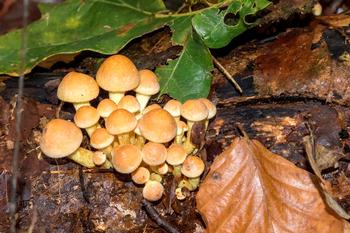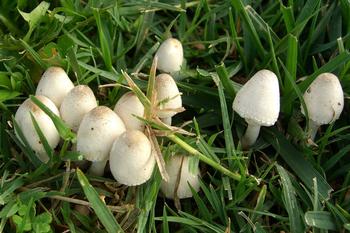
The mushrooms that appear after a rain are the reproductive structures of underground fungi. Photo: Pixnio.com
Those mushrooms that pop up in your garden after a good rain may be unsightly, but they are more likely to be beneficial rather than harmful to your plants. Once you understand why they appear in your garden, you may appreciate them more. However, they can be dangerous to you if ingested, so it’s best to consider them all inedible and leave it to the experts to determine whether they are delicious or deadly.
Mushroom is a general term applied to the above-ground fruiting bodies of certain kinds of spore-forming fungi. Typically, we think of a mushroom as having a stem, a cap, and gills on the underside of the cap. These types of mushrooms appear annually when conditions are right and last only long enough to release their spores. Shelf fungi or bracket fungi growing on tree trunks or fallen logs can also be called mushrooms but are often referred to as conks. Most of these are perennial and grow and toughen as they age. They, too, produce spores but tend to have pores rather than gills.

Most mushroom producing fungi in lawns are beneficial because they decompose organic matter. Photo: Jason Hollinger, Mushroom Observer.org
When mushrooms spores reach a favorable place to grow, they send out long thin filaments called hyphae. The hyphae form thready networks known as mycelium. The mycelial networks are the basic fungal structures that produce mushrooms. Because mushroom-producing fungi do not manufacture chlorophyll, they are dependent on other organic matter for survival. Many of these fungi are saprophytic and absorb nutrients from dead plant materials in the soil. They are the recycling crews that break down complex organic compounds into essential elements that other organisms can use. In this way, they contribute to the health of the soil. For example, the fairy ring fungi causing the circular patterns in lawns feed on buried dead plant material rather than grass.
Some underground fungal hyphae form symbiotic relationships with plant roots called mycorrhizae. Through this mutually beneficial partnership, the fungi provide decomposed nutrients from the soil to the plant, and in return, the plant supplies the sugars the fungi need. Many native and landscape plants depend on fungi and mycorrhizal relationships for optimal health and growth. Some of these mycorrhizal partnerships are specific between a plant and a fungus, while others are less specialized. For example, oak trees can form mycorrhizae with many different fungi resulting in a variety of mushrooms common in oak woodlands. Among these are the Amanitas, which are advantageous to the oaks but toxic to humans if eaten.

Mushrooms growing on living tree trunks are a sign of fungal infection. Photo: UC Regents
Certain mushrooms are cause for concern. While most mushroom-producing fungi grow in dead organic matter, some are parasitic and invade living plant tissue. These types of fungi can cause trunk and limb decay by attacking the sapwood or the heartwood in woody plants. Stressed or injured trees are most susceptible to parasitic fungi. The appearance of mushrooms on a landscape tree should prompt further attention. Armillaria root rot shows up as mushrooms growing in honey-colored clusters at the base of trees or shrubs. While conks are commonly seen on fallen trees, they signal problems if they appear on living tree trunks.
When mushrooms appear in your garden, you first need to notice where they are growing. If you see them on compost, tree stumps, wood chips, or other dead plant material, then consider the fungus that produced them as beneficial. It’s doing its job of decomposing and making nutrients available to other plants. Mushrooms emerging long after the rains can indicate an irrigation problem needing follow-up. If you find mushrooms unsightly or are concerned about children or pets ingesting them, then pick and dispose of them. To reduce the spread of spores in your garden, toss them in the green bin rather than in your compost pile. However, if you find mushrooms on living plants or trees, you should investigate further for signs of decay and consult an expert if necessary. An infected tree can present a hazard even if the damage is not visible.
 The mushrooms that appear after a rain are the reproductive structures of underground fungi. Photo: Pixnio.com
The mushrooms that appear after a rain are the reproductive structures of underground fungi. Photo: Pixnio.com Most mushroom producing fungi in lawns are beneficial because they decompose organic matter. Photo: Jason Hollinger, Mushroom Observer.org
Most mushroom producing fungi in lawns are beneficial because they decompose organic matter. Photo: Jason Hollinger, Mushroom Observer.org Mushrooms growing on living tree trunks are a sign of fungal infection. Photo: UC Regents
Mushrooms growing on living tree trunks are a sign of fungal infection. Photo: UC Regents


